Stockholm
King Gustaf III (1746 –1792) founded the Royal Theatre in 1773, two years after his ascent to the throne, in order to promote plays and operas in Swedish. When he split the troupe into two in 1788, he gave theatre life in the Swedish capital an impulse that has rolled on until today: the dramatic theatre, the Dramaten, and the opera and ballet theatre were born. Both institutions still exist today, meanwhile based in new buildings: the Royal Opera in a neo-classicist theatre from 1898, the Dramaten in a beautiful art nouveau theatre from 1908.
As a side effect, the Södra Theatre (1858) has become the oldest preserved theatre building in the city centre. The Stockholm Circus building opened in 1892 and still operates today as a venue for theatre productions and events. A second interesting art nouveau theatre is Oscar's Theatre (1906).
But the most fascinating tour leads to the theatres in the royal palaces in the outskirts of Stockholm:
Ulriksdal, Drottningholm and Gripsholm.
Turist information
Stockholm Tourist Centre
Tel.: +46 (0)8 508 285 08
info(at)svb.stockholm.se
www.visitstockholm.com
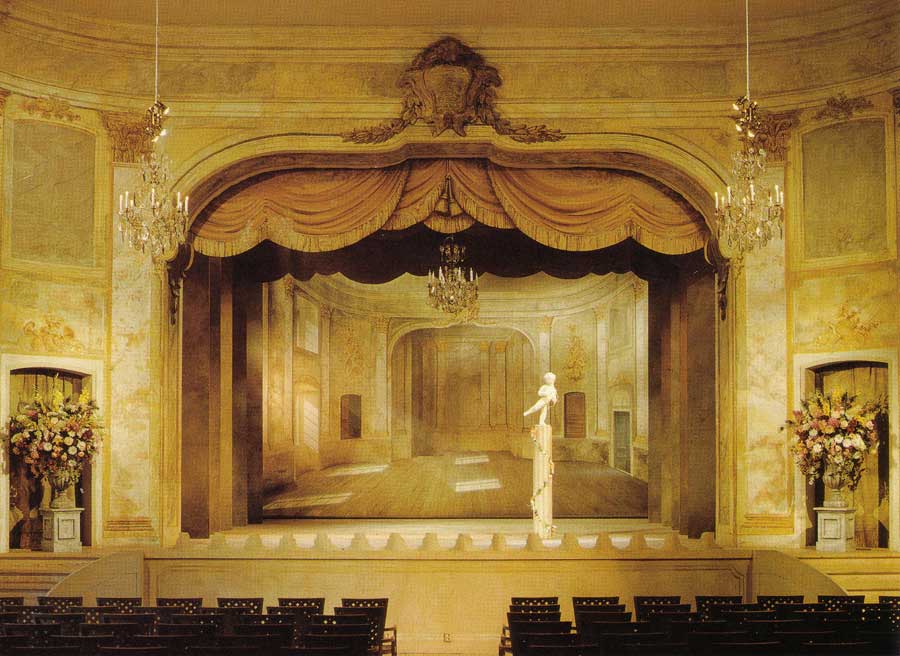 Confidencen
Confidencen
The Court Theatre at Ulriksdal Palace features the oldest original theatre interior in Sweden, designed 1753 by the theatre architect Carl Fredrik Adelcrantz. The building itself had originally been constructed as riding stables in the 1670’s. On Queen Lovisa Ulrika’s initiative it was converted into a theatre. Next to the auditorium, elegant salons were furnished for the royal family and their guests. The grand central salon is equipped with a "table à confidence", i.e. a dinner table that can descend, through a trapdoor, to a kitchen in the basement where it can be laid and then hoisted upwards again. In this way the royal family could dine without any eavesdropping servants. The theatre is named after this salon. The rococo-style auditorium holds more than 200 seats. In 2003 a reconstruction of the old stage machinery was realized and a new set of scenery in the style of the 1700’s was made especially for Confidencen. Managed by opera singer Kjerstin Dellert, Confidencen offers an extensive summer season of drama, opera, concerts and ballets.
Confidencen - Ulriksdals Slottsteater ⋅ 170 79 Solna ⋅ Sweden ⋅
Tel.: +46 (0)8 85 70 16 ⋅
Tickets for performances: + 46 (0)8 85 60 10 ⋅
E-mail: info(at)confidencen.se ⋅
www.confidencen.se
Visits: guided tours on appointment from May to September
Tourist office
Solna Forum
Tel.: +46 (0)8 734 24 90
E-mail: solna.forum(at)solna.se
www.solna.se
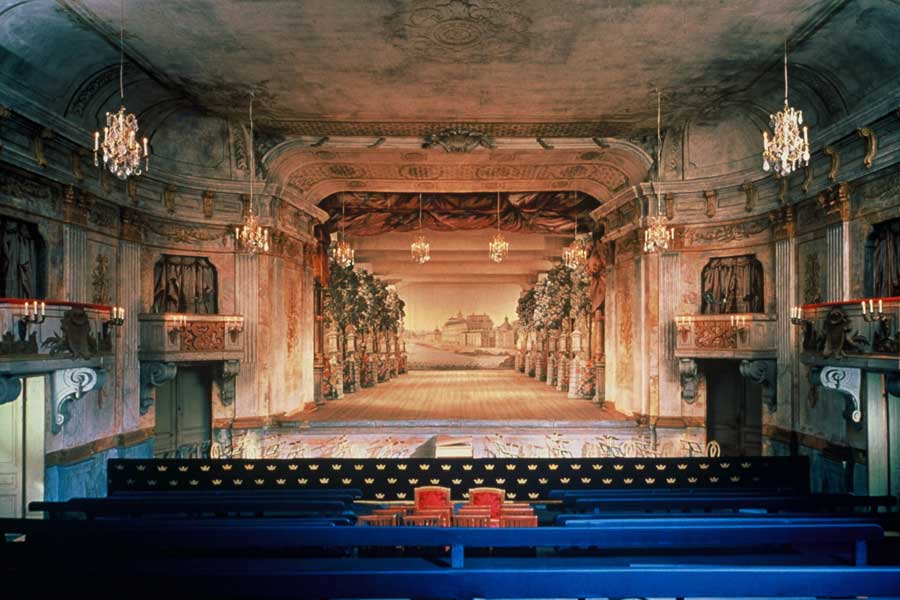 Drottningholm Court Theatre
Drottningholm Court Theatre
Drottningholm Court Theatre, located just outside Stockholm, was built at the request of Queen Lovisa Ulrika by Carl Fredrik Adelcrantz. It was completed in 1766 and has been preserved in its entirety until today. Thus even today, the original stage machinery allows for quick changes of scenery, and in addition there are moving waves, trapdoors, cloud carriages and wind and thunder machines. A unique collection of original 18th century scenery is also being preserved. The heyday of the theatre began in 1777 with Gustaf III who initiated drama and opera in the Swedish language. Following his death in 1792 the theatre was closed. And it stayed closed for 130 years, until it was rediscovered in the 1920’s. Every summer the theatre presents a festival of 18th century opera, concerts and family events. This festival started already in 1946, making it one of the longest running festivals in Europe. In 1991, Drottningholm Court Theatre was proclaimed a UNESCO World Heritage.
Drottningholms Slottsteater ⋅ 178 93 Drottningholm ⋅ Sweden ⋅
Tel.: +46 (0)8 759 04 06 ⋅
E-mail: dst(at)dtm.se ·
www.dtm.se
Visits: guided tours May – August daily 11:00 to 16:30,
September daily 12:00 to 15:30,
October and April Friday to Sunday 12:00 to 15:30
Tourist office
Ekerö Turism
Tel.: +46 (0)8 560 233 95
E-mail: info(at)ekeroturism.se
www.ekeroturism.se
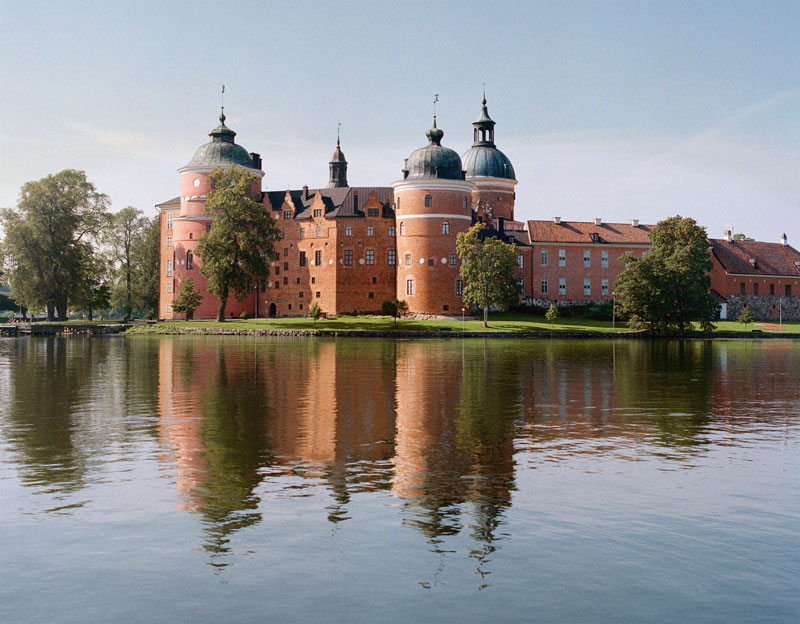 Gripsholm Palace Theatre
Gripsholm Palace Theatre
Just 70 km from Stockholm lies Gripsholm Castle, the summer palace of King Gustaf III on Lake Mälaren, easily accessible also by boat from the capital.
The king's private palace theatre was completed in 1781. It was designed by the Swedish architect Erik Palmstedt who was inspired by his travels in Europe, especially by Palladio's Teatro Olimpico in Vicenza, Italy. He used the circle shape of one of the castles's four round towers to create an intimate amphitheatre that offers seats for some sixty guests, whereas the non-gentile audience could watch through the "lorgnettes" in the dome. Gripsholm Palace Theatre has been preserved in its entirety since the last recorded performance in 1785. The stage set displayed on stage today is the one used when the play "Drottning Christina" (Queen Christina) was given before the Court. Being part of the palace museum, which also presents the portraits of the National Portrait Collection, the theatre can be visited daily, including a good view of the 18th century stage machinery below the stage.
Gripsholms slott · 647 31 Mariefred · Sweden ·
Tel.: +46 (0)1 59 101 94 (weekdays 8:00 to 17:00) ·
E-mail: info.gripsholms-slott(at)royalcourt.se ·
www.kungahuset.se/royalcourt/royalpalaces
Visits: daily 10:00 to 16:00 (15 May – 30 September) ·
Guided tours for groups on appointment, also outside the season
Tourist office
Mariefreds Turistbyrå
Tel.: +46 (0)1 59 297 90
E-mail: turism(at)strangnas.se
www.strangnas.se
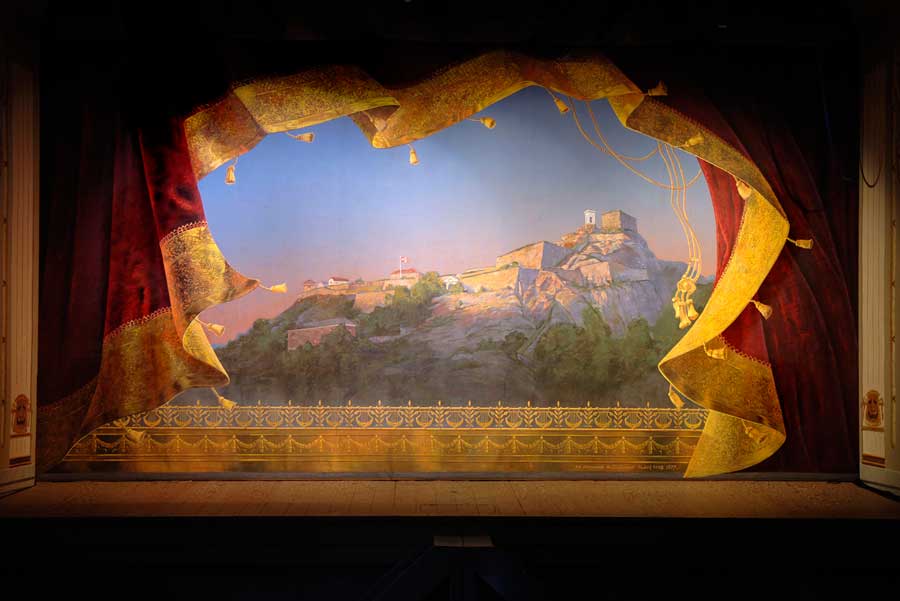 Fredrikshald Theatre
Fredrikshald Theatre
Norway‘s best preserved historic theatre opened in 1838. Designed by the engineer officer at Fredriksten fortress, B. N. Garben, it was financed by the members of the Music theatre association and the Dramatic arts association in Halden (Fredrikshald), and expanded in 1850 with banqueting rooms and a kitchen. The theater is an Empire style building with symmetrical façades; the stage, too, has been preserved, featuring a simple mechanism for scene changes. An extensive restoration campaign was completed in 1982 and a new dressing room block added. Fredrikshald Theatre has an extraordinary collection of stage sets from the 19th century which will be shown in a former mission house. The building and the collection are owned by Halden historiske Samlinger (Halden History Museum). The theatre operates as a theatre and event location within the antiquarian and museum requirements.
Fredrikshalds Teater ⋅ Teatergata 3 ⋅ Halden ⋅ Norway ⋅
Postal address: c/o Ostfoldmuseene - Halden historiske Samlinger ⋅ Herregårdsveien 10 ⋅ 1771 Halden ⋅ Norway ⋅
Tel.:+47 (0)91 57 91 31 ⋅ +47 (0)47 81 64 66
E-mail: hhs(at)ostfoldmuseene.no
www.ostfoldmuseene.no
Visits: please see website for dates of guided tours;
otherwise on appointment
Tourist office
Halden Turist
Tel.: +47 (0)69 19 09 80
E-mail: info(at)visithalden.com
www.visitoslofjord.com
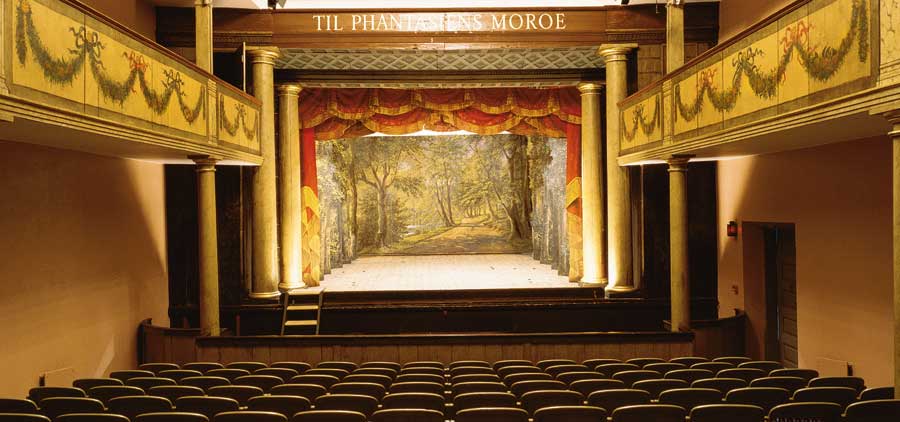 Elsinore Theatre
Elsinore Theatre
Helsingør Theatre, inaugurated in 1817, was originally built and run by the local dramatic society in Helsingør (Elsinore) north of Copenhagen, and was used as a banqueting hall as well as a theatre. It was unique, because it was financed by the residents of the town themselves, in contrast with the royal theatres and those built by the nobility in the 17th and 18th centuries. Thus it was a symbol of the bourgeois public sphere of the period, where the wealthier middle classes became more prominent as patrons of the arts. In its last years the theatre also served as a cinema, but as the times required more up-to-date facilities for showing films, the theatre was condemned for demolition. However, the building was saved, and in 1961 it was moved to The Old Town (Den Gamle By) in Aarhus, an open-air museum portraying life in the old Danish market towns. The theatre stands today as the oldest in Denmark that is still preserved in its original form, and is still used for numerous opera and theatre performances and concerts during the year.
Helsingør Teater ⋅ Viborgvej 2 ⋅ 8000 Aarhus ⋅ Denmark ⋅
Tel.: +45 (0)86 12 31 88 ⋅
E-mail: mail(at)dengamleby.dk ⋅
www.dengamleby.dk
Visits: guided tours only; please contact the museum about the details.
The Old Town minimum opening times are daily from 10:00 to 17:00; January till mid-March 11:00 to 15:00
Tourist office
Visit Aarhus
Tel.: +45 (0)87 31 50 10
www.visitaarhus.com
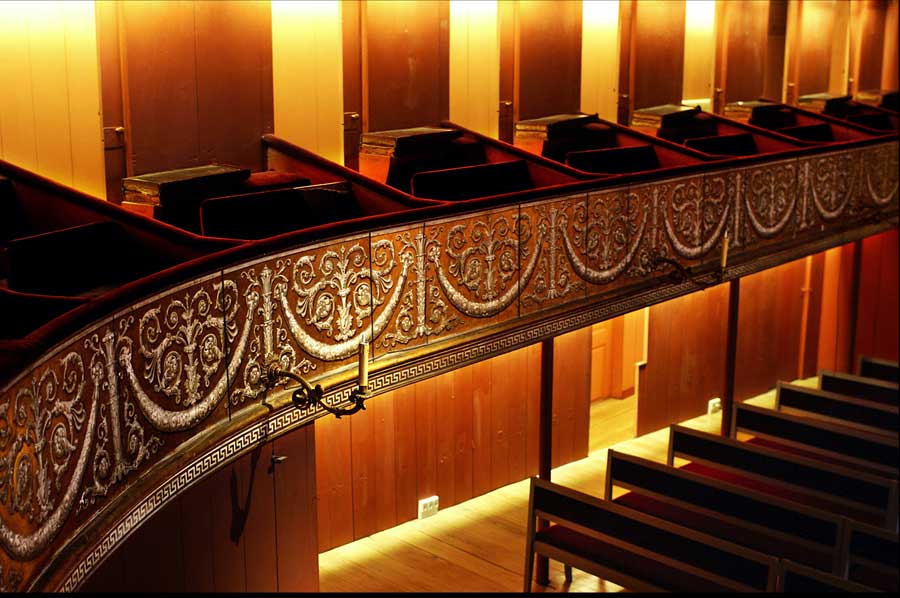 Court Theatre
Court Theatre
The Theatre Museum at the Court Theatre is part of the palace area Slotsholmen in the centre of Copenhagen, surrounded by historic buildings and institutions. Below the Theatre Museum at the Court Theatre there are the Royal Stables and Christiansborg riding ground, where the Royal horses and the Danish military horses are daily taken out for a ride. In 1766, the original arsenal on the first floor was transformed into a neoclassical theatre in pearl grey and gold, with balconies supported by 22 columns. Traces of this neoclassical theatre can still be found in the entrance and the foyer. In the early 1840s the last absolute king, Christian VIII, had the auditorium transformed into the Biedermeier interior of red velvet and boxes that is seen today. Visitors may move freely around the auditorium, the stage, the balconies and the small boxes, enjoying the permanent exhibition on Danish theatre history as well as special exhibitions on various theatre topics. The Theatre Museum at the Court Theatre also presents a broad spectrum of museum activities and cultural events.
Teatermuseet i Hofteatret ⋅ Christiansborg Ridebane 18 ⋅ 1218 København K ⋅ Denmark ⋅
Tel.: +45 (0)33 11 51 76 ⋅
E-mail: teatermuseet(at)teatermuseet.dk ⋅
www.teatermuseet.dk
Visits: Tues, Weds, Thurs 11:00 to 15:00,
Sat & Sun 13:00 to 16:00 ⋅
Guided tours can be pre-booked
Tourist office
Wonderful Copenhagen
Tel.: +45 (0)7022 2442
E-mail: touristinfo(at)woco.dk
www.visitcopenhagen.dk
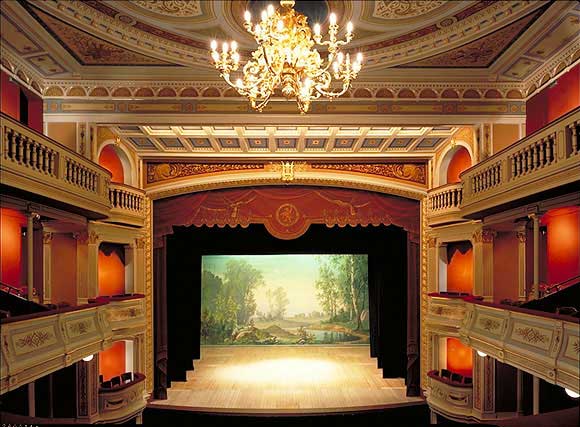 Ystad Theatre
Ystad Theatre
Ystad Theatre enjoyed an extensive restoration campaign from 1989 to 1993 that brought back the old splendour to this 1894 theatre. One of the most splendid parts is the collection of original stage sets from the workshop of Sweden’s then most prominent theatre painter, Carl Ludvig Grabow. On the technical side, the stage features an ingenious combination of old and new. When the theatre opened in 1894, its new machinery for movable scenery was already considered out of date. The era of Baroque, when this technology had been invented, was definitely over. So it remained unused, and its wooden drums and shafts, chariots and wheels disappeared bit by bit over the years. When Per Simon Edström came looking for it in 1992, he found parts of it all over the theatre. So he started to reassemble the machinery. Today, the theatre combines the old, reconstructed machinery in the understage with modern machinery above the stage – thereby allowing for contemporary performances as well as for performances in the old style. Ystad’s theatre presents over 200 performances every year and is probably best known for the summer opera that celebrates its 35th anniversary in 2013 and also for the Ystad Sweden Jazz Festival..
Ystads Teater ⋅ Sjömansgatan 13 ⋅ 271 43 Ystad ⋅ Sweden ⋅
Tel.: +46 (0)411 57 77 99 ⋅
E-mail: teatern(at)ystad.se ⋅
www.ystadsteater.se
Visits: guided tours on appointment (pre-booking)
Tourist information
Ystads Turistbyrå
Tel.: +46 (0)411 577 681
E-mail: turistinfo(at)ystad.se
www.ystad.se
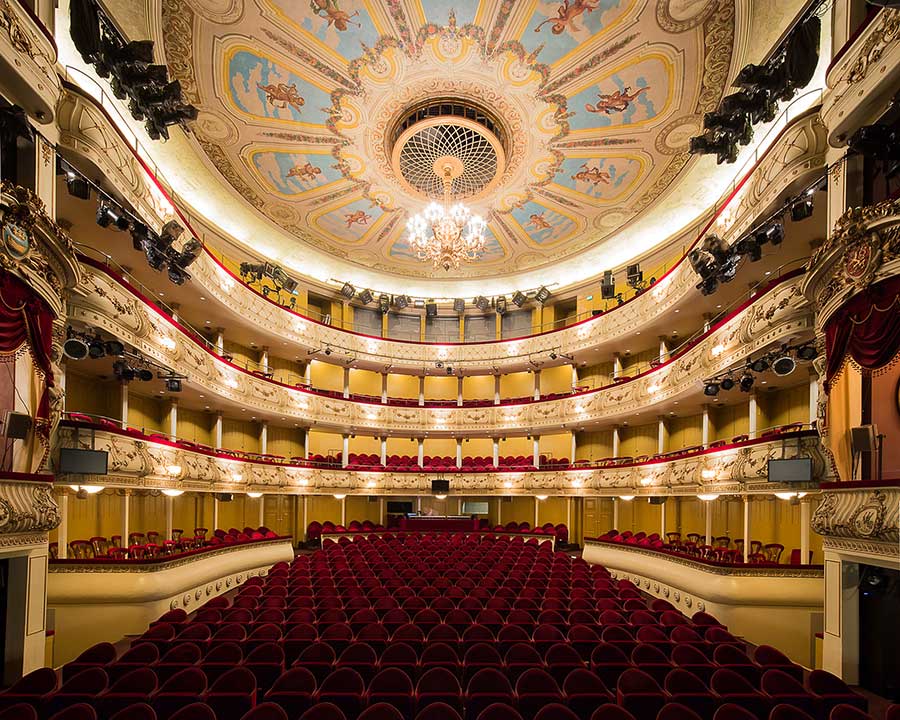 Swedish Theatre
Swedish Theatre
Finland was under Swedish rule for about 400 years, and it still has a large Swedish speaking population. Swedish is Finland’s second official language, and one of its national theatres is the Swedish theatre, beautifully located at the Esplanade Park. Its characteristic semi-circular walls date from an earlier theatre that burned down in 1863. The present building was designed by the Russian architect Nikolai Benois and opened in 1866. His golden auditorium is still the heart of the building. In the 1930s two side wings were added and the facade was stripped simple, giving the 19th century theatre a surprising 20th century appearance. Its three different stages offer a broad repertoire for everyone – in Swedish, with Finnish and English surtitles.
Svenska Teatern · Norra esplanaden 2 · 00130 Helsinki · Finnland ·
Tel: +358 (0)9 6162 1411 ·
E-Mail: info@svenskateatern.fi ·
www.svenskateatern.fi
Visits: on appointment
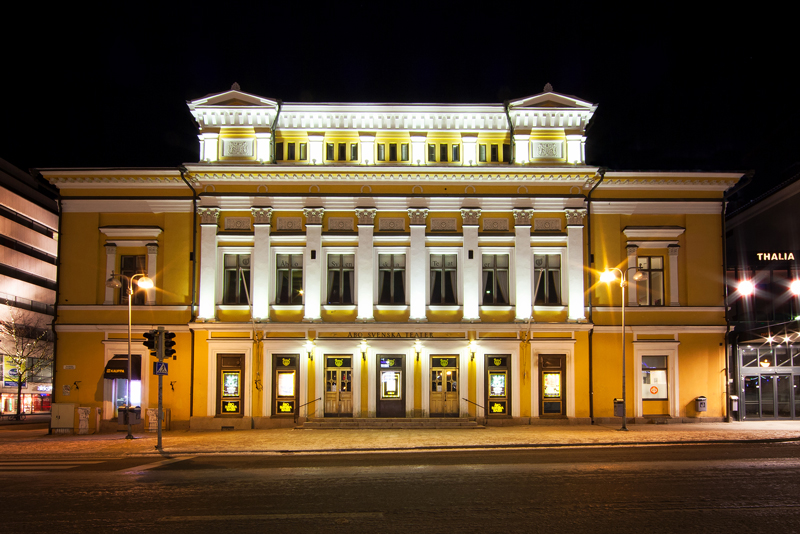 Åbo Swedish Theatre
Åbo Swedish Theatre
Åbo is the Swedish name for Turku, just two hours away from Finlands capital Helsinki, and this theatre is one of the few Swedish language theatres in Finland. It is also the oldest still existing theatre building in the country. The facade and the walls are still the original ones from 1839, whereas the cosy interior dates mainly from the 1890s, including a beautiful painted ceiling by K.G. Wetterstrand and a curtain by the famous Swedish theatre painter Carl Grabow. The permanent repertory company performs plays and musicals, and also tours the country.
More sights to see in Turku are the old Cathedral and the Castle, both older than 700 years. The river Aurajoki, that runs through the city, provides an idyllic environment for relaxing walks. The riverside is brimming with lovely restaurants (both on land and on restaurant boats), museums, shops and cafés.
Åbo Svenska Teater · Eerikinkatu 13 · 20100 Turku · Finland
Tel: +358 45 650 46 08
E-mail: maria.olin@abosvenskateater.fi
www.abosvenskateater.fi
Visits: Guided tours in the theatre and behind the scenes on appointment
The nordic Route |
The Nordic Route connects unique historic theatres in Denmark, Norway, Sweden, and Finland. (Please move your cursor along the Route to get detailed information on the theatres.)
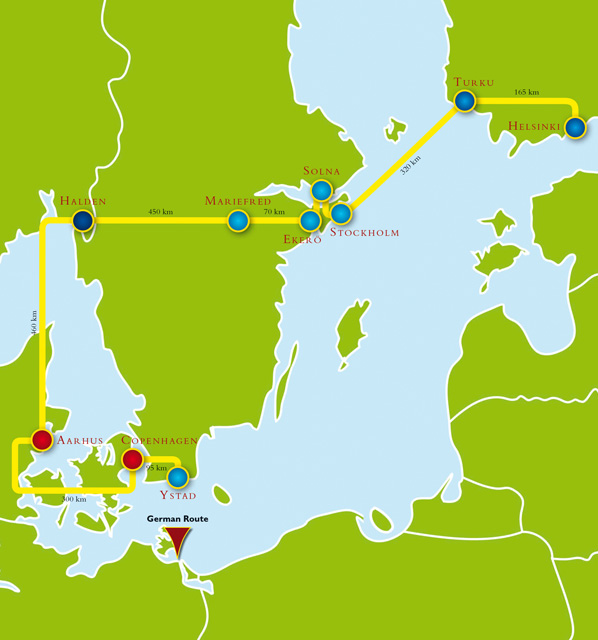
In the beginning of Nordic theatre history, kings and queens played their part. Thus our journey starts just outside Stockholm, at Drottningholm Court Theatre (1766), built at the request of Queen Lovisa Ulrika, and still completely preserved today. Not far away, in Solna, we find Ulriksdal Palace and Confidencen, a royal theatre constructed already in 1753, also at the request of the Queen. Her son, King Gustaf III, founded the National Opera, the National Dramatic Theatre, and the Royal Academy of Music in order to foster plays, operas and performances in the Swedish language. His very own private theatre from 1785 is part of Gripsholm Palace in Mariefred and preserved entirely. When the king was murdered at a masked ball at the Stockholm opera house, all three palace theatres were closed and remained so for more than 100 years.
Travelling west along the lakes and through the forests of Sweden and crossing the border into Norway, we arrive in the city of Halden, not far from Oslo. Fredrikshalds Theatre (1838) houses Norway’s best preserved historic stage, original stage sets and props. Originally built by a local theatre group and the city, it was carefully restored in 1982.
Taking a ferry, we go to Denmark and to Aarhus, where we find Elsinore Theatre (1817) which was moved here from Hamlet's hometown in 1961. Financed by the townspeople, it gives us a clear picture of middle class public life in this period.
In Copenhagen, the danish king had his Court Theatre built in 1767. Remodelled by a successor in the mid-19th century, it is today the home of the national Theatre Museum.
From Denmark, the Oresund Bridge takes us into the south of Sweden and to the theatre in Ystad, built 1893-94 in the neoclassicist style. Ystad Theatre was one of the last theatres in Europe to be equipped with a “baroque” stage machinery; for the 100th anniversary this was restored to working conditions. Ystad theatre also holds a unique collection of original stage sets made by C. L. Grabow, a famous set designer who worked for many Nordic theatres. Take a ferry from here via the island of Bornholm to the island of Ruegen and continue on the German Route...
To get the most out of the Nordic Route one should travel between May and September since some of the theatres are only open during this period. Please check opening hours and seasons for each theatre.
With the support of the Culture Programme of the European Union

 Deutsch
Deutsch English
English Français
Français
